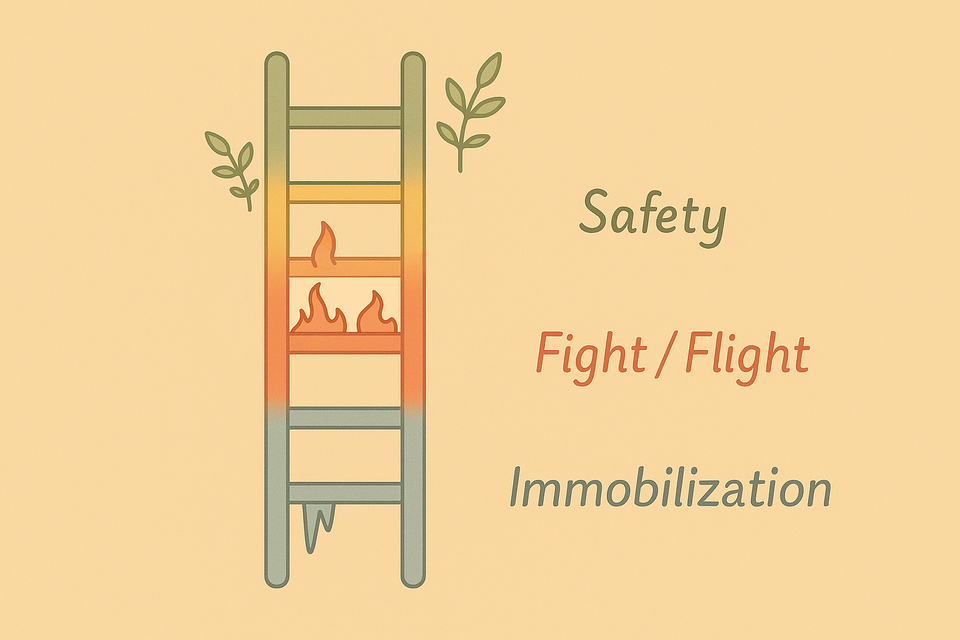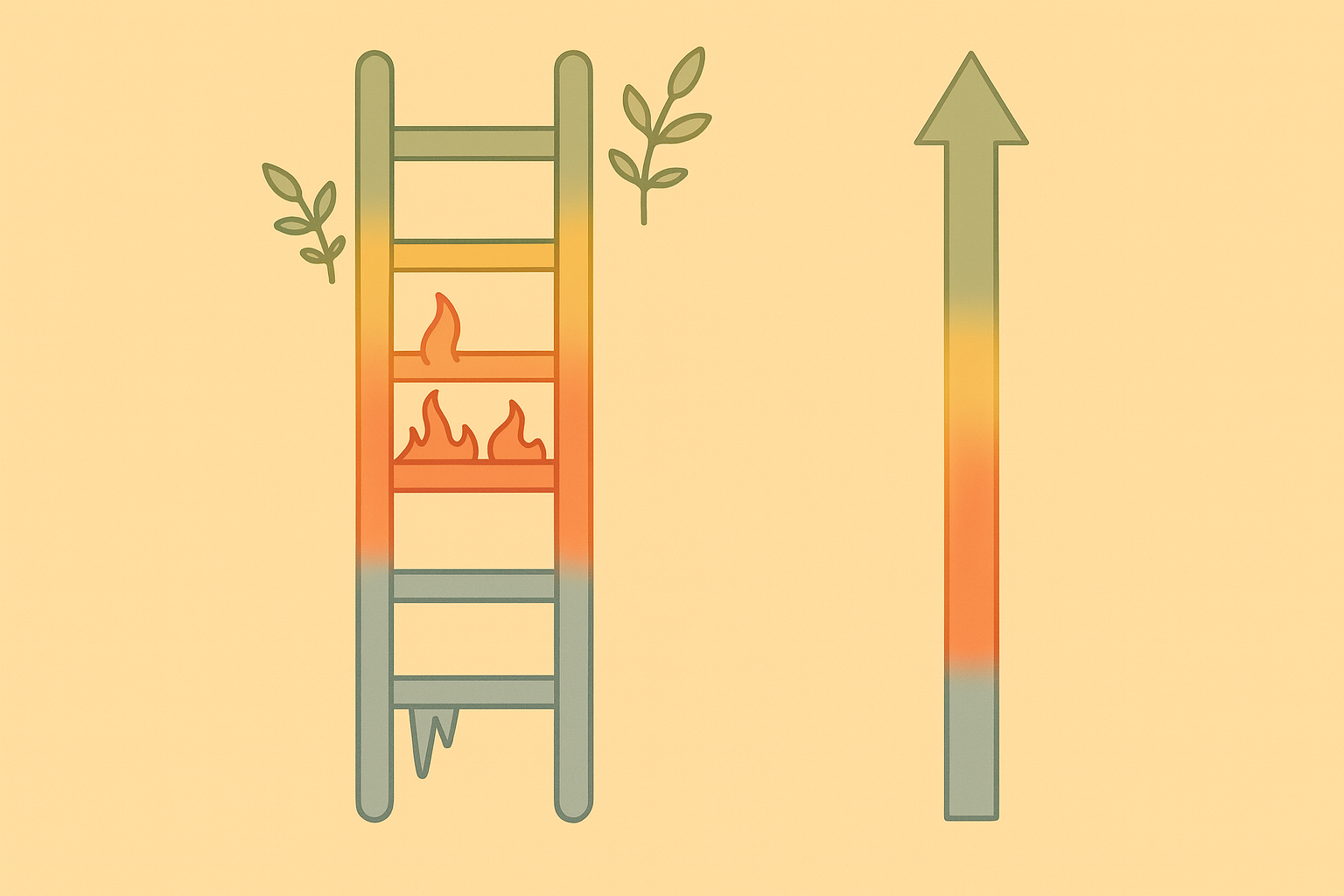Understand your nervous system: The Polyvagal Theory

Learning more about my nervous system was a turning point in my recovery. It gave me insights that helped me become an active participant in my own healing.
In this post, I’ll walk you through:
- The three states of the nervous system described by the Polyvagal Theory
- How to recognize your own states
- Practical ways to guide your nervous system back toward safety
How the nervous system works
According to the Polyvagal Theory (by Stephen Porges), the nervous system oscillates between different states to respond appropriately to what’s happening around us. We could call this "nervous system resilience".
But sometimes, when the nervous system has been overwhelmed (by a virus, trauma, adverse life experiences...) it can become maladaptive and start detecting threats everywhere (through no fault of your own, it is a biological mechanism!).
Being chronically stuck in survival states may alter how our cells behave: this is described in the Cell Danger Response theory (Dr Robert Naviaux). Cells keep redirecting their resources toward defense, leading to dysfunction across many body systems, including energy production.
Let’s take a closer look at the different nervous system states and how we can help it return to a sense of safety.
The 3 states of the nervous system
Also called "ventral vagal" or "parasympathethic"
This is the rest-and-healing state, and also the state that allows social engagement. It’s the state we’re meant to spend most of our time in. It allows us to feel connected to others, to ourselves, and to our surroundings:
Thoughts
I am safe.
I am at peace.
I belong.
I am having fun.
Feelings
Secured, calm, happy, open, curious, hopeful...
Bodily sensations
Slow and deep breathing, slow heart rate, relaxed muscles and face...
Also called "sympathetic" or "mobilization"
This is the stress-and-activation state. In healthy individuals, occasional stress can be very useful: to react to danger of course, but also to get moving, make decisions, exercise, play!
The catch is that we can’t stay in that mode for too long, otherwise it becomes toxic for the brain and body:
Thoughts
I am worried.
I need to get out of here.
I have to solve this right now.
Feelings
Tense, anxious, angry, overwhelmed, extra sensitive to sensory stimulus...
Bodily sensations
Quick and shallow breathing, high heart rate, overthinking, hot flushes, muscle tension, shakiness, GI issues...
Also called "dorsal vagal" or "shutdown"
This is the nervous system’s last layer of protection. When the brain senses a threat that can’t be dealt with by fighting or fleeing, it "shuts down" to protect you:
Thoughts
I can't cope.
Nothing is working.
I am alone.
Feelings
Numbness, dissociation, depression, hopelessness...
Bodily sensations
Exhaustion, low muscle tone, heaviness, slow thinking, slow metabolism...
You can also experience mixed states.
For example, in order to play football, you need a mix of 🌱 Safety (human connection, enjoyment) and ⚠️ Fight-Flight (movement, reactivity, excitement).
A mix of ⚠️ Fight-Flight and 🪫 Immobilization is often called "Freeze": you feel highly anxious and urgent, yet stuck at the same time.
A mix of 🌱 Safety and 🪫 Immobilization often shows up during moments of intimacy or deep rest.
Your body and brain are never acting against you or trying to punish you with symptoms. Their only goal is to protect you (granted, sometimes not very gracefully 😅). The good news is that you can help your system return to safety.
Going back to safety
1- Mapping your states
First, it’s very helpful to map your states and notice how each one feels in your own body. I listed above some common thoughts, feelings, and sensations for each state, but everyone’s experience is unique.
Here are my personal examples:
- My ⚠️ Fight-Flight often comes with nausea, chest tightness, and dry mouth. I also become intolerant to noise, extremely annoyed by small things, and I have racing anxious thoughts.
- My 🪫 Immobilization state brings exhaustion, discouragement, low self esteem, and brain fog.
Be curious: Observe how you feel and try to identify which state you’re in. It can shift several times throughout the day!
Sometimes what feels like calm isn’t actually safety.
For people who’ve been unwell for a long time, the nervous system can settle into a numb state that feels peaceful on the surface, but is actually immobilization. And the brain forgets what actual safety feels like.
This was a big insight I learned from Dr Sally Riggs in her book, Recover. Focusing on getting out of immobilization became my first recovery step.
2- Shifting your state
It’s helpful to know which state you’re in, because each one has specific strategies that can help you shift out of it. Here are a few examples, but you’ll probably need to experiment and find what works best for you in each state.
Get out of ⚠️ Fight-Flight
Here we’re aiming to settle the system into a calmer state, to quiet the alarm bells ringing in the brain:
- Slow deep breathing
- Orienting (gently look around and describe what you see to remind your brain you’re safe)
- Mindfully observe sensations in your body (only if they’re not too intense, here's a nice guided practice)
- Shake your body or dance or walk outside (only if you have the energy)
Get out of 🪫 Immobilization
Here we’re trying to gently activate the system and reconnect with the present moment:
- Gentle movement (e.g., wrist or ankle rotations)
- Soothing touch (e.g., hand massage, lightly stroking your arms)
- Talking or sitting with safe people or pets
- Watching something funny
- Sitting in nature
- Connecting to your 5 senses (the softness of a blanket, a pleasant scent, the taste of good food, a beautiful view or artwork)
Good to know
Think of the three states as steps on a ladder.
When you’re in 🪫 Immobilization, you're at the bottom of the ladder. Your system will have to climb through the ⚠️ Fight-Flight step before reaching 🌱 Safety (on top of the ladder).
It may result in a paradoxical sensation as you get better: in 🪫 Immobilization you probably felt relatively "calm" with fatigue but also slow thinking. When you'll improve, you'll move up on the ladder and reach ⚠️ Fight-Flight, which will probably make you feel much more agitated and anxious.
You will probably oscillate between those two states for a while as you recover. It can feel uncomfortable, but it is temporary and completely normal. Welcome each state with calm and trust, and you'll naturally reach 🌱 Safety.

When in doubt or too tired, I would do the simplest thing: focus on slowing my breath down and allow whatever was here. Letting go is a true key to healing.
Conclusion
You don’t need to jump from full panic or full disconnection straight to full safety in one go. That’s hard to do, especially in the beginning.
Even a 1% shift in your state (slightly calmer thoughts, feeling a bit more connected, or a little less tense) is a win!
Small shifts can also add up throughout the day.
Write down the practices that help you the most so you can remember what to do when you get stuck in a difficult state. When we’re in the thick of it, it’s much harder to connect to the rational brain. Having a nice note ready can help a lot!
If you want to keep reading, you can have a look at what helped me expand activity thanks to pacing, or how I'm dealing with setbacks.
